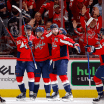Jan. 5 vs. Carolina Hurricanes at Capital One Arena
Time: 7:00 p.m.
TV: MNMT
Stream: MonSports.net/Stream
Radio: 106.7 The Fan, Capitals Radio 24/7
Carolina Hurricanes (21-13-4)
Washington Capitals (18-12-6)
Washington’s five-game homestand continues on Friday night when the Carolina Hurricanes make the first of two trips to the District this season. Friday’s game is the second meeting between the Caps and Canes this season; the Caps prevailed by a 2-1 count in a shootout in Raleigh on Dec. 17.
That aforementioned game in Raleigh just under three weeks ago was part of rugged and grueling patch of scheduling in which Washington had to travel to play each of a dozen straight games from Dec. 10-Jan. 3. That stretch came to a merciful end on Wednesday in a 6-3 loss to New Jersey in the first game of the homestand, and the back half of a set of back-to-backs, Washington’s fifth set of back-to-backs in a span of 26 days.
Every team has difficult patches of scheduling over the course of six months and 82 games, and a team’s ability – or lack thereof – to thrive or remain afloat during those stretches can be critical in determining whether it makes the playoffs or not.
The Caps started the stretch of a dozen games on Dec. 10 in Chicago, and they are one of just three of the NHL’s 32 teams to play as many as a dozen games over that span; no team played more. The Caps finished that stretch with a 5-4-3 mark, tied for 20th in the NHL (from a points percentage standpoint, .542) over that span.
Toronto also played a dozen games during that same time frame. The Leafs played three sets of back-to-backs during the same span, and they also had the luxury of a three-game homestand in the midst of their stretch. Like the Caps, Toronto also went 5-4-3, tied for the 20th best mark in the League over that time.
Detroit is the third team to skate in a dozen games since Dec. 10. Like Toronto, the Wings also had fewer back-to-backs (two) than the Caps over the same span, and they were also able to play consecutive home games, something the Caps haven’t done since Dec. 7-9. At 4-8-0, Detroit has the League’s 28th best record since Dec. 10.
None of the three teams has thrived over the last four weeks, but despite being the only team of the trio to play five back-to-backs and to travel for every game, the Caps certainly stayed afloat. But they can’t exhale yet, either. Washington is still in the midst of a critical stretch of its season, and they will enter Friday’s game with the Canes with just one victory in their last six games (1-3-2).
For just the second time this season, the Caps enter Friday’s game with three power-play goals in their last two games. Earlier this season, the Caps endured an 0-for-34 drought with the extra man, and they’ve managed to climb from last to 25th in the circuit in that department; the Washington power play crew is at 12.8 percent on the season heading into Thursday’s NHL action.
Over their last 11 games, the Caps’ power play is 8-for-29 (27.6%). Each of Washington’s three power-play goals in the last two games has come in the last 90 seconds of a period, and each has been generated by the Caps’ second power play unit, a group consisting of Connor McMichael, Aliaksei Protas, Anthony Mantha, Rasmus Sandin and captain Alex Ovechkin.
Not only has the Caps’ second power play unit contributed some desperately needed offense, it has also able to swing the momentum back to Washington’s side in the wake of some of those lamplighters.
“The power play scoring is one thing,” says Caps’ coach Spencer Carbery. “But also, in the moments where you need something, it was big for us [Wednesday].”
Carbery also elaborated on what the second unit is doing that has allowed it to have more success than the team’s top extra-man quintet of late.
“Puck recoveries and entries, unfortunately,” says the Caps’ bench boss. “It’s just a struggle right now [for the first unit] to gain entry, and I just find that their entries are very, very disconnected and sloppy, and they’re just not sure where we’re going. And that’s partly on us, to figure out a combination of how that looks.
“The second unit is much more direct. We’re not really worried about how we enter; we just know we’re going to go earn the puck back. And that sometimes can be the best recipe. When you have that mindset that we don’t care how this puck’s getting in, if we have to rim it, if we have to soft chip it. If we get a clean entry, great. But we know we’re going to go work to get it back, and now all of a sudden you consistently get the puck back. And that’s what they’re doing.
“It’s giving them a chance to get set up in zone and see what’s cooking. It’s not always going to work out; [it’s] not every entry that you gain possession that you’re going to score, or get a scoring chance, but it at least gives you a fighting chance. And that’s what the first or top unit – or however you want to describe it – isn’t even getting to that point a majority of the time.”
Since the Caps saw them in Raleigh midway through last month, the Canes have caught fire. Carolina carries a four-game winning streak to town, and the Hurricanes are 5-1-1 since that shootout loss to Washington in mid-December.
Carolina’s recent surge has been fueled by a hot streak from winger Andrei Svechnikov, the 23-year-old former second overall pick in the 2018 NHL Draft. Already in his sixth NHL season, Svechnkiov carries a five-game multipoint streak with him as his team takes on the Caps on Friday. Svechnikov has six goals and 11 points in his last five games, and he has 23 points (eight goals, 15 assists) in as many games this season.
Most recently, the Canes put a 6-1 hurting on the New York Rangers on Tuesday night at Madison Square Garden, pulling to within five points of the frontrunning Rangers in the Metro Division standings. Svechnikov bagged a pair of goals in Carolina’s Tuesday night victory.



















